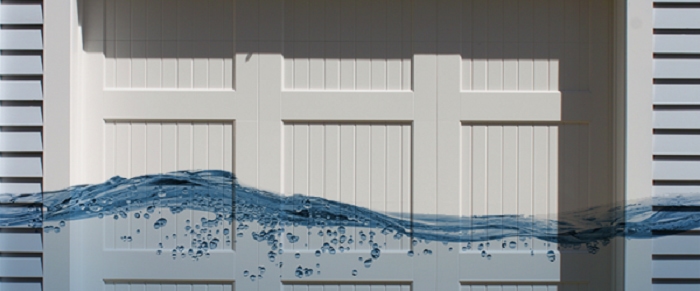Here's How to Keep Water Out of Your Garage

Not only do we provide the best Parker garage door installation, but we also give great advice!
If you’re having trouble keeping water out of your garage, there are three areas of concern: wet walls, a wet garage floor, and water leaking underneath your garage door.
This guide will walk you through all of the potential causes of why water may be in your garage- and how to keep it out.
Worrisome Wet Walls
You can’t see through walls, so you need to know what to look for in order to identify water in your walls. These are the four most common causes of wet walls, how you can identify them, and how you can remedy them.
Roofing Problems
Bad shingles and loose flashing can let rain into exterior walls by traveling along framing studs.
You can notice that water is moving through your garage walls if the corners between your walls and your floor are wet. This is because the water from the walls eventually reaches the garage floor and shows itself there.
If you have a roof that’s in need of repair, it can cause serious damage to your garage walls.
Faulty Plumbing
Washing machines and water heaters are typically located in the garage, with water lines hidden behind the walls.
While this prevents unsightly pipes from dangling all around your garage, it also poses a threat to your garage walls in the case of something going wrong.
A sign that something may be wrong with your plumbing is if you find puddles on the garage floor that are on the same wall as one of your appliances.
Call a plumber to get the leak fixed as soon as possible.
Aging Sill Plates
Sill plates are the first pieces of wood laid out when your house is being built. They keep your home attached to its foundation.
Aged sill plates leak sometimes, which can lead to water in your garage. When looking for water, check the horizontal sills at the bottom of framed walls where they come in contact with the floor.
You should replace bad sills, but caulk or foam can often stop the leak. If you’re taking the time to replace your bad sills, improve your whole garage by getting new overhead doors!
Old Joint Seams
Old joint seams on exterior walls often leak when it rains or snows. Look at all of your wall seams, specifically around doors and windows.
Save yourself the trouble and seal your garage wall seams with waterproof foam or caulk.
Disastrous Wet Garage Floors
Suddenly you’re finding puddles on your garage floor. While this can be worrisome, the causes are typically easy to identify. Wet garage floors can almost always be traced back to one of these three problems.
Remember, great overhead door installation can help you avoid having a wet floor in your garage.
Floor Cracks
Floor cracks can be the perfect highway to bring ground moisture into your garage, no matter how small the cracks may be.
Moisture will only cause cracks to grow and make new ones develop, so it’s a vicious cycle that needs to be stopped.
Clean your floor cracks thoroughly and then fill them in with a concrete patching compound that’s water-resistant.
Warm Weather Condensation
When warm air reaches cold concrete, it causes condensation that turns into water on your floor.
If your dryer vent isn’t in tip-top shape, your garage may be filled with hot, moist air. Get your dryer vent cleaned to avoid warm, wet air escaping into your garage.
Even without a faulty dryer vent, spring and summer are bound to bring hot air into your garage. The best overhead doors help keep heat out to lessen the hot weather’s impact.
Run a dehumidifier to counteract the moisture in the air and replace the reservoir regularly.
Surface Pitting
When concrete floors age, they eventually become pitted with tiny holes that create the perfect spots for moisture to reside.
If your garage floors are decades old and are starting to get wet, it might be time to seal your floor with a silicate-based product. Regular floor paints won’t do the trick unless they contain a moisture barrier.
Surface pitting can be hard to see, so this shouldn’t be your go-to solution unless you’ve investigated your other options and had no luck.
Water Leaking Under Garage Doors
No one wants water to be sneaking underneath their garage doors. Some of these problems are easily fixed, while others require a bit of a more intensive cure.
While you’re fixing this leak, consider a new garage door installation to avoid any future leaks caused by a faulty garage door.
Driveway Pitch
If your garage is built below the grade line of your property, it’s a no-brainer that gravity will pull the water into your garage.
Your best bet is to install a channel drain that redirects water away from your garage door.
Driveway Grade
If the ground beside your driveway is above the driveway itself, rain will be redirected onto your driveway and sent to your garage door.
This can be remedied by lowering the grade around your driveway. If possible, you should hire professionals to do this for you.
Worn-Out Weather Strips
The rubber strips that are on the bottom of your garage door don’t last forever. Eventually, wear and tear will get the best of them and they will start letting in everything from rain to snow to pests.
Check your weather strip every couple of months to see how it’s doing. When you replace it, you can get rubber floor seals for extra protection.
Old overhead doors may also be letting water in from the top, so it’s important to get them replaced when the time comes.